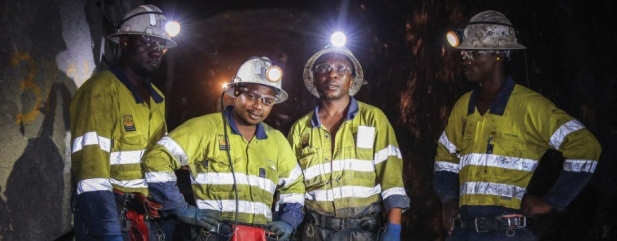Archived article
Please note that tax, investment, pension and ISA rules can change and the information and any views contained in this article may now be inaccurate.
Gold hits six-year high and sends mining share prices soaring

The price of gold has hit $1,426 per ounce for the first time in six years. The precious metal has been in hot demand as a result of the weakening US dollar and America’s central bank raising concerns over the health of the country’s economy.
Gold typically does well when the stock market does badly, as investors see the relative stability of its price as a safe place to put their money.
It is called a ‘safe haven’ asset because it typically keeps its value even when the market is turbulent. Another safe-haven asset for example is German government bonds, because it’s deemed highly unlikely Germany will go bust and default on its debt.
At its most base level, the idea of buying gold comes from the notion that the entire world system could one day collapse and therefore gold will become the default currency, so you’ll be using it to buy your groceries. But Shares deems the likelihood of this happening to be almost zero.
WHY THE RUSH?
The gold rush would suggest investors are getting nervous. People in finance like to use the term ‘wall of worry’ when there are a lot of market issues keeping them up at night.
At the moment there are concerns global economic growth won’t be as good as people thought, and they’re also worried about America’s trade tensions with China and now Mexico getting out of hand.
In addition, the US dollar has weakened after the US central bank the Federal Reserve signalled it would resist pressure to cut interest rates.
It comes after another rush back in February as investors were again scared of a global economic slowdown, as well as a no-deal Brexit and the ongoing trade war.
In a research note earlier this month, analysts at UBS had forecast the gold price to reach $1,400 per ounce in the next year.
They said: ‘We continue to advocate gold as an insurance asset, as we believe it can help shield investors from geopolitical flare-ups, macro data disappointments and sharp gyrations in financial markets.’
CENTRAL BANKS SEEK SAFE HAVEN
It’s not just investors hoping to make a quick buck who are piling money into gold. Further support for gold comes from central banks, who according to UBS have added over 145 tonnes to their reserves in the first quarter of this year, having added more than 651 tonnes last year, the most in 47 years.
Together with other factors, it’s expected that central bank demand will help to continue pushing the gold price higher.
While there may be a rush now, the gold price has held relatively stable at around $1,200 to $1,300 per ounce for the past four years. This is why in times of market adversity people rush to snap up gold.
For example, when the FTSE 100 fell to a four-year low of 5,536 on 11 February 2016, gold had already been in a rising price trend for the previous four weeks and remained in an uptrend for some time after. It moved from c$1,100 per ounce in January that year to exceed $1,360 per ounce six months later.
GOLD MINERS VS GOLD
Investors wanting to get exposure to gold can do so in several ways. In addition to buying gold coins or bullion, you can buy exchange-traded funds which track the gold price such as iShares Physical Gold (SGLN), opt for investment funds which invest in gold miners like BlackRock Gold and General (B5ZNJ89), or buy individual gold mining shares.
Gold miners can rise by a greater amount than an appreciating gold price – and also underperform when gold falls in value.
Year-to-date, gold miners worth more than £40m on the London Stock Exchange have risen by an average of 28%, compared to a 12% rise in the gold price.
Resolute Mining (RSG) last week floated on the London Stock Exchange, offering investors exposure to three mines in Australia, Ghana and Mali.
An approximate £450m market cap makes Resolute the sixth largest gold miner listed on the UK stock market. Read this article to learn more about the company.
The best performer is Trans-Siberian Gold (TSG:AIM), which has seen its share price more than double this year as the company benefits from the rising gold price and from recent efforts to raise awareness about the business. Previously one to shun engagement with UK investors, the miner last year changed its approach and has been actively promoting its story.
The worst performer is Avesoro Resources (ASO:AIM), down 60% year-to-date as a result of operational and financial setbacks.
It is important to note the risks of investing in gold miners. You have to consider geopolitical risks such as the government of the country where a miner is doing business deciding to remove licences or impose extra taxes; operational risk as mines rarely run smoothly; and financial risk as many miners take on considerable debt when building new projects.
While miners with some or all of these negative issues can still rise in value when gold is soaring ahead in price, their shares can crash when gold pulls back in value.
Important information:
These articles are provided by Shares magazine which is published by AJ Bell Media, a part of AJ Bell. Shares is not written by AJ Bell.
Shares is provided for your general information and use and is not a personal recommendation to invest. It is not intended to be relied upon by you in making or not making any investment decisions. The investments referred to in these articles will not be suitable for all investors. If in doubt please seek appropriate independent financial advice.
Investors acting on the information in these articles do so at their own risk and AJ Bell Media and its staff do not accept liability for losses suffered by investors as a result of their investment decisions.

 magazine
magazine











